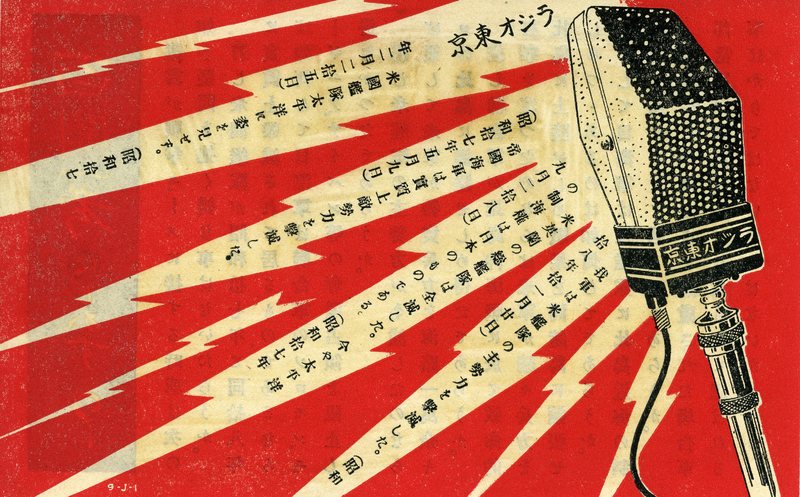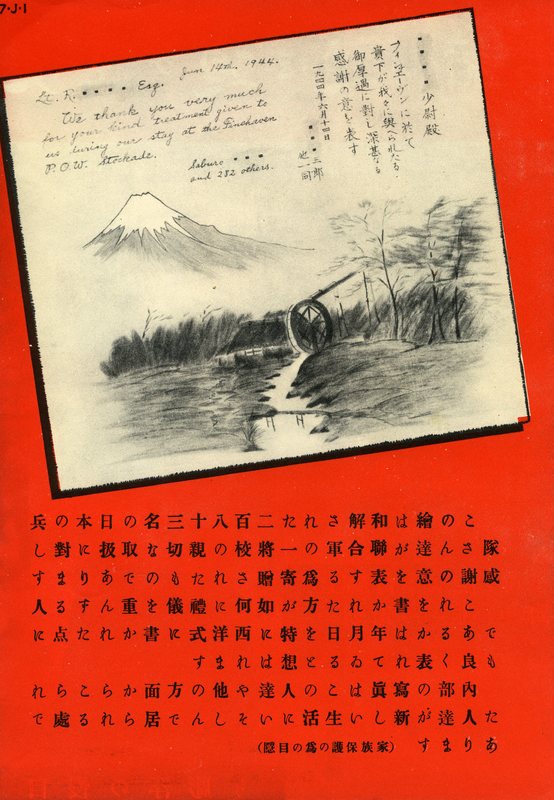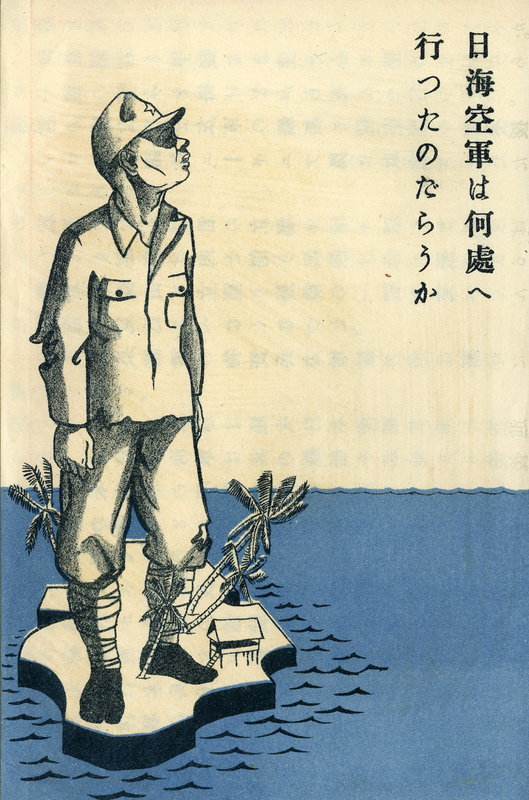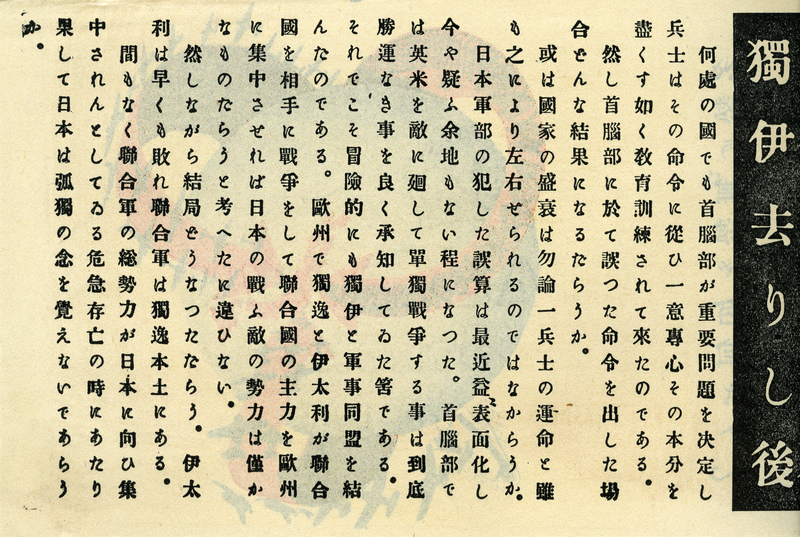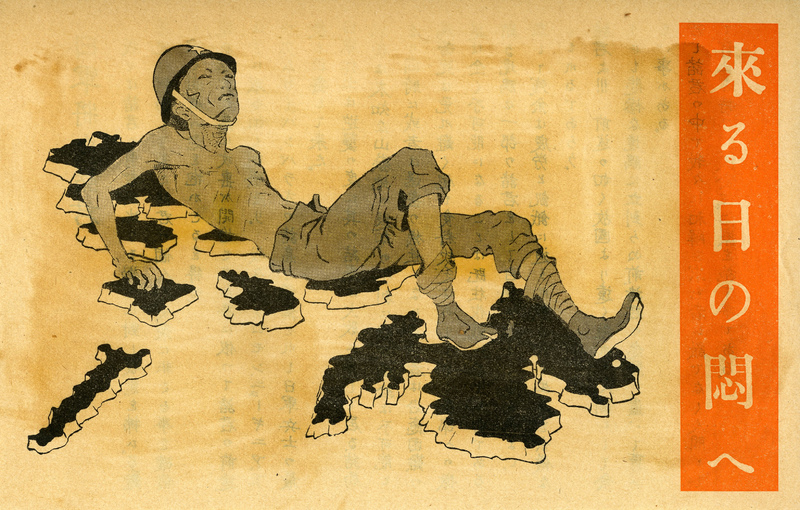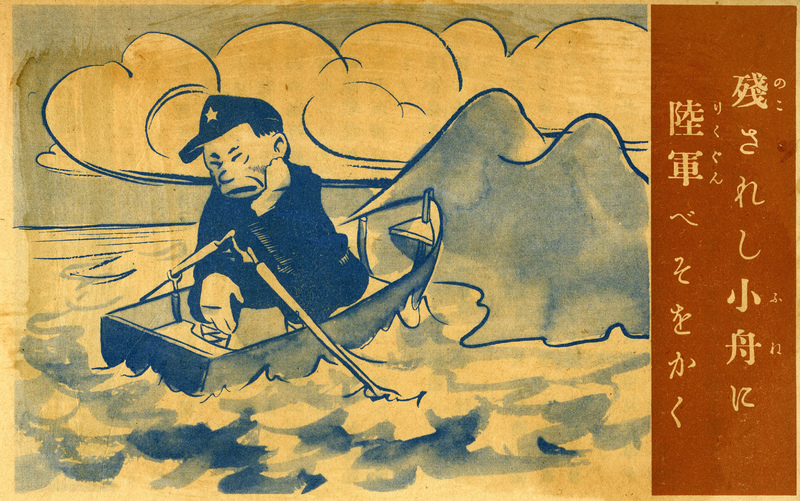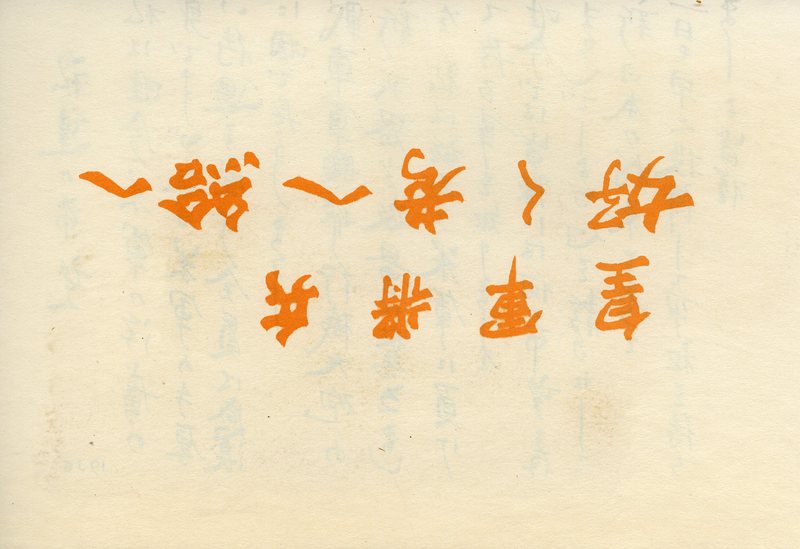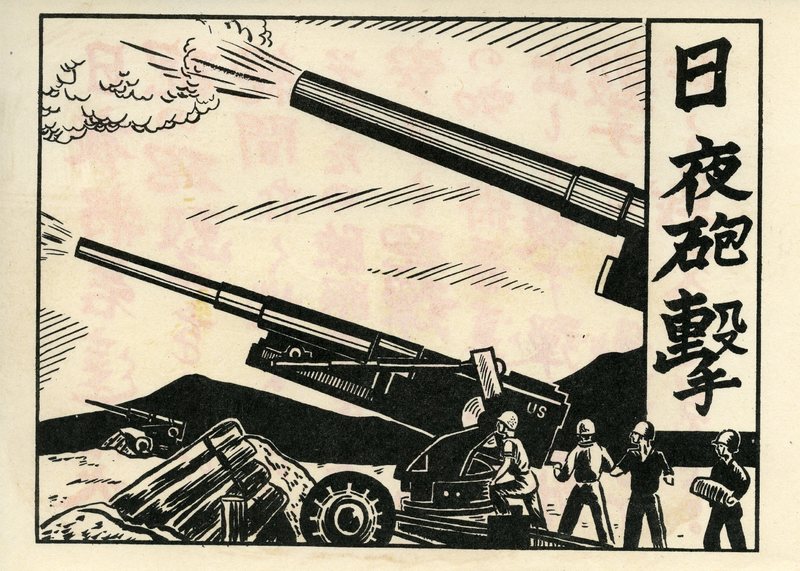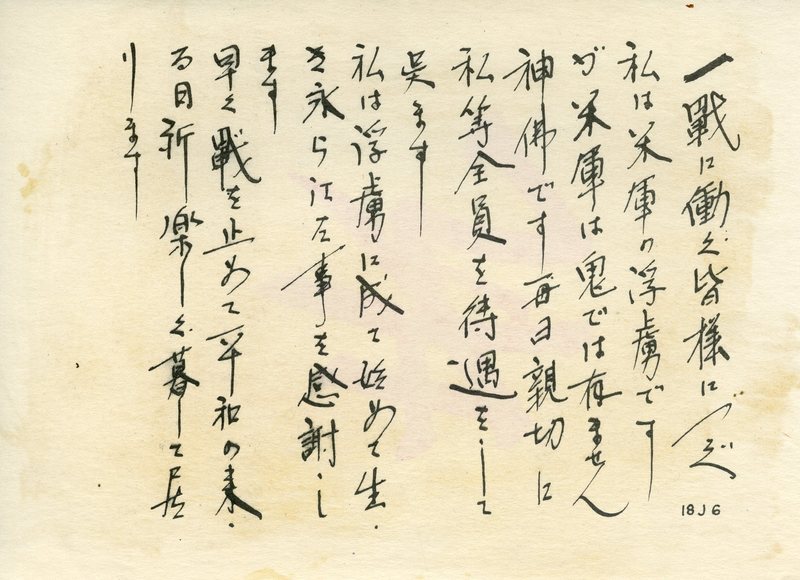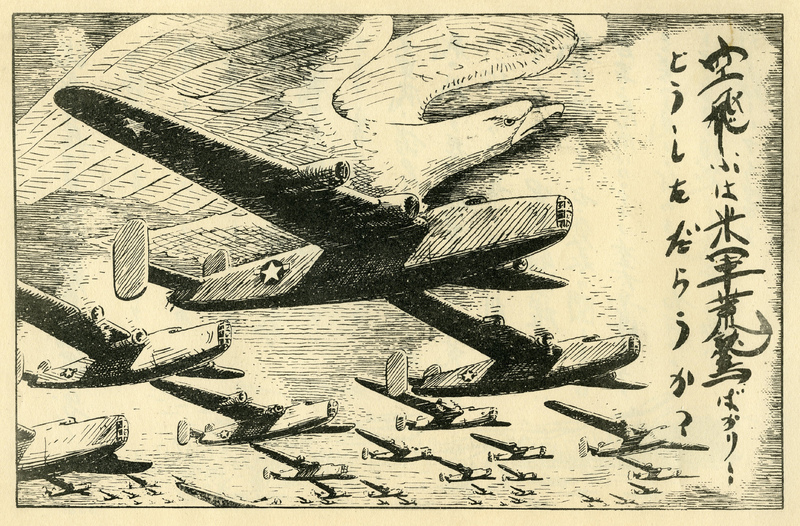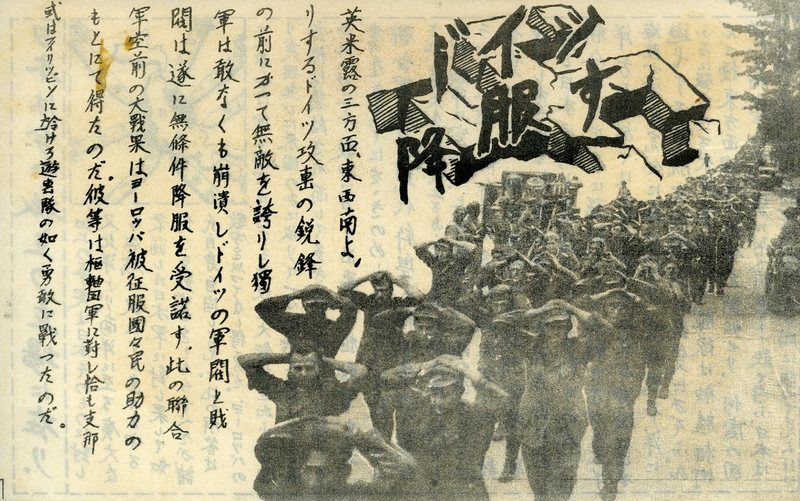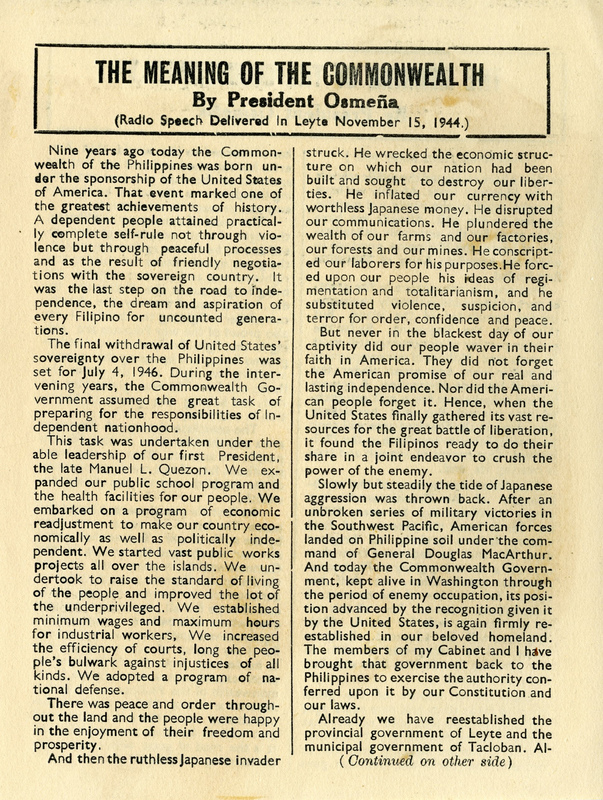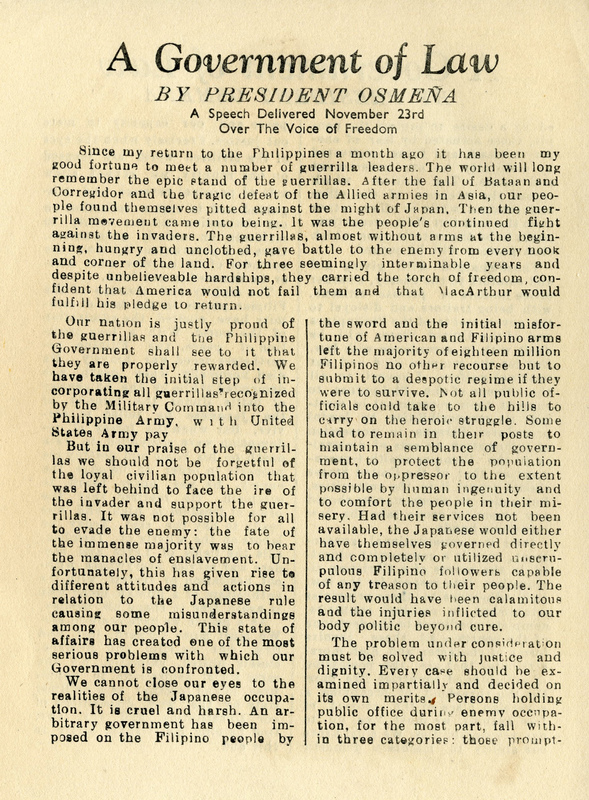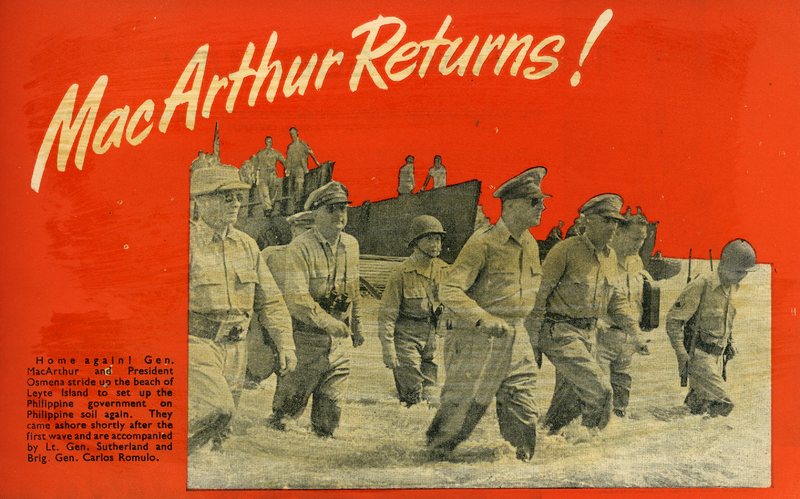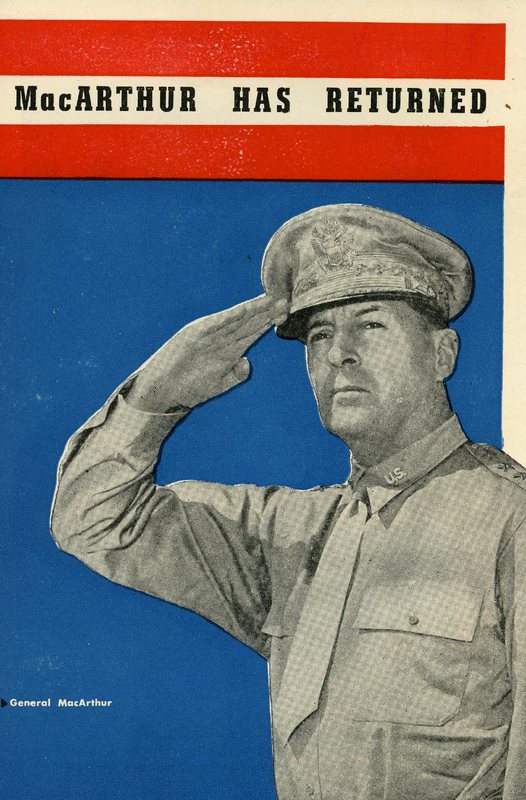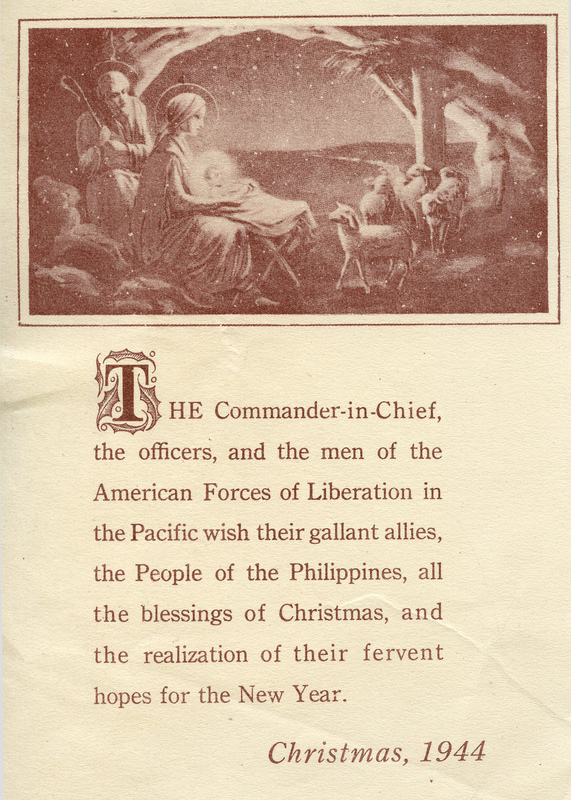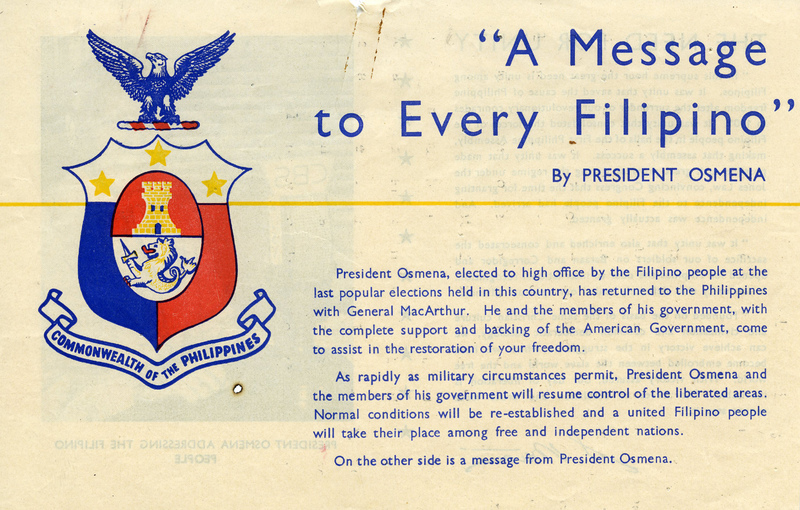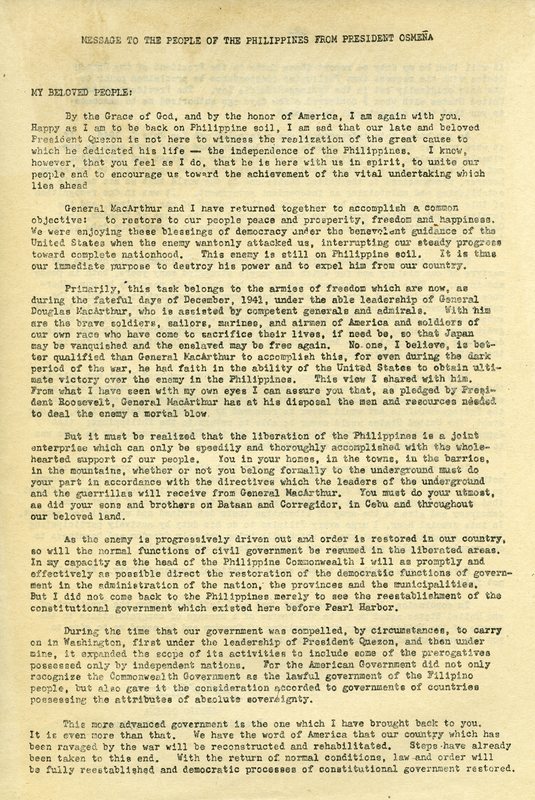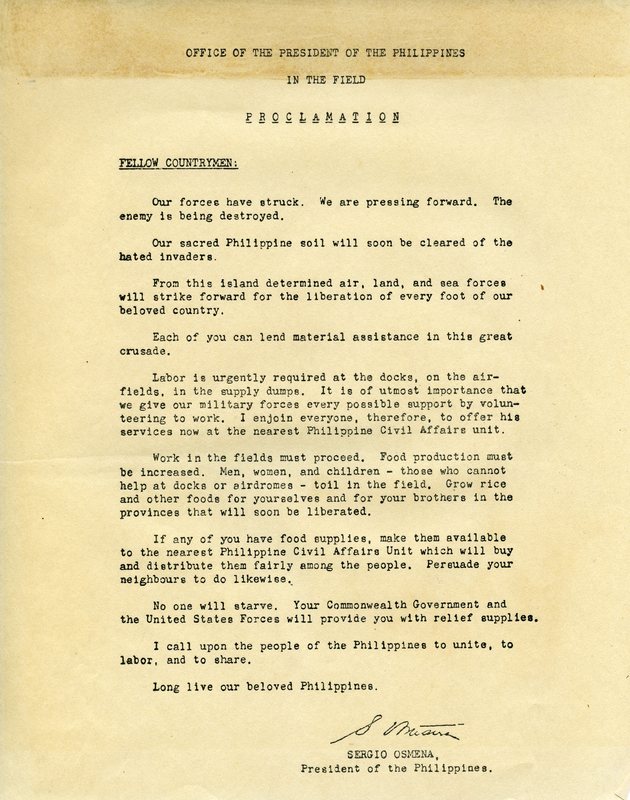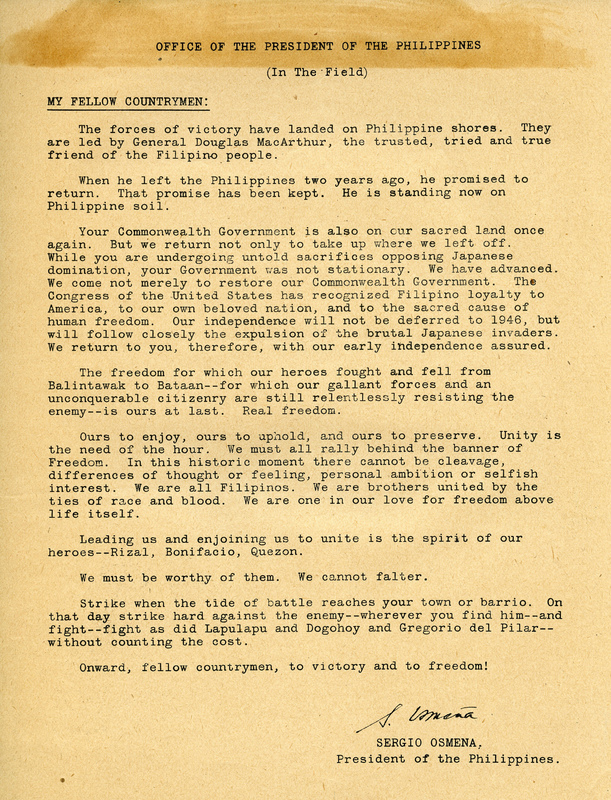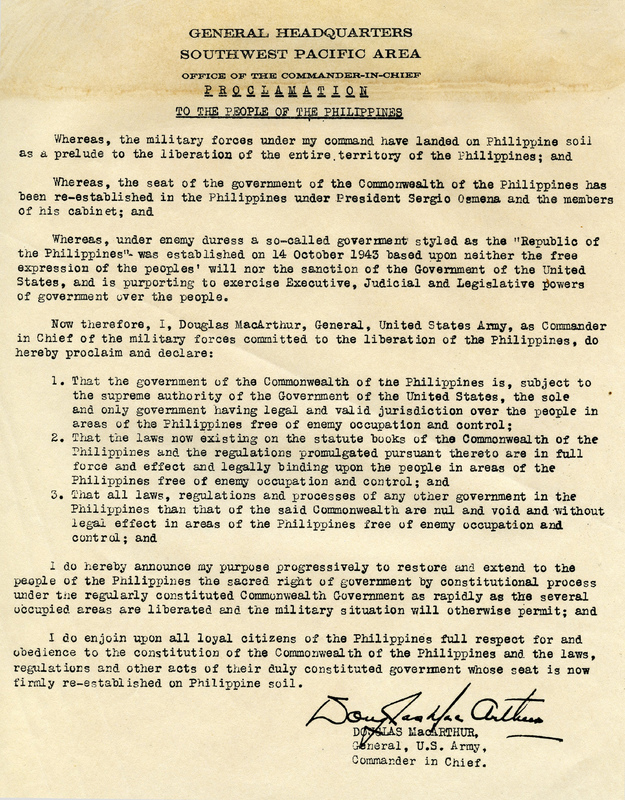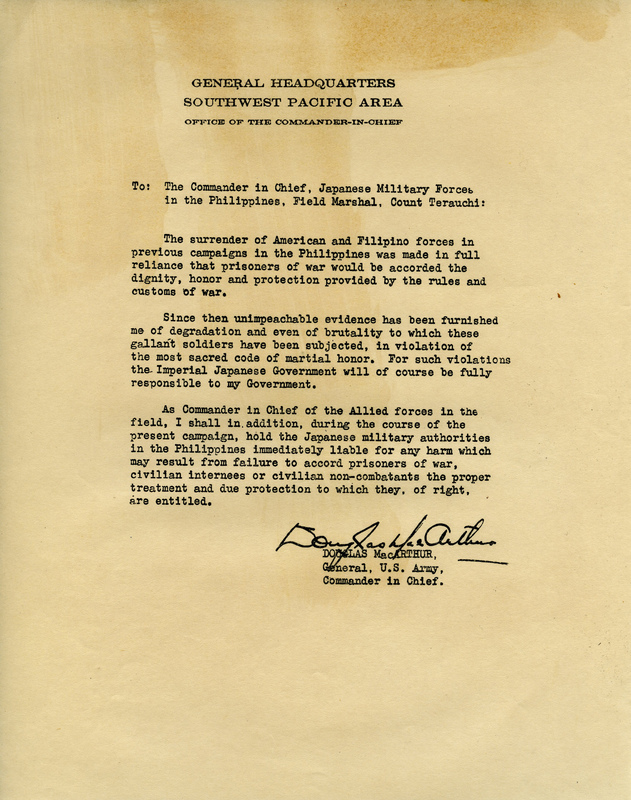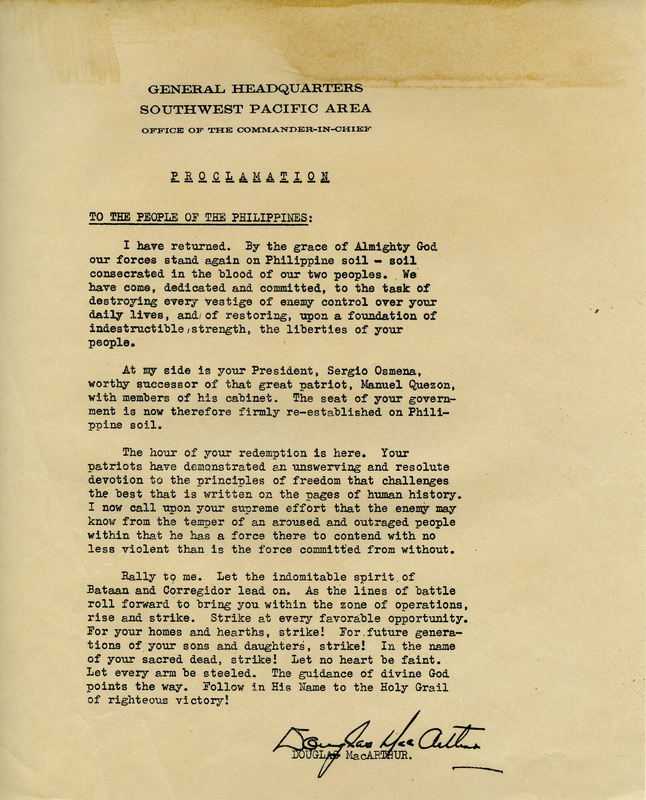WWII Propaganda Leaflets from the Baldwin Scrapbook
- Title
- WWII Propaganda Leaflets from the Baldwin Scrapbook
- Description
- The Psychological Warfare Branch of the United States Armed Forces was a military unit that created and distributed propaganda during the Second World War. The scrapbook contains approximately 200 pieces of their propaganda, mostly in Japanese, that were intended for distribution in the Philippines, Japan, and other nearby areas. Each item is accompanied by a typed translation into English. Pacific University Archives MS.70
Items
-
'Truth of Leaders' propaganda leafletA propaganda leaflet issued by the Allied Forces during World War II after the return of General Douglas MacArthur to the Philippine Islands. The leaflets were probably airdropped on the Philippine Islands to Japanese troops still fighting, soon after General MacArthur landed in October, 1944. It uses excerpts from Tokyo radio broadcasts dated between 1942-1943, in which reports stated multiple times over the course of two years that the American fleets had been destroyed. The leaflet calls into question the reports that the Japanese troops had been receiving from their leaders. It was meant to induce the surrender of Japanese troops by driving a wedge between troops and military leaders. The leaflet is numbered '9J1'. The leaflet is accompanied by an official description and translation of the text into English. This is one item from a scrapbook of propaganda leaflets and related materials that was compiled by the Psychological Warfare Branch of the Allied Forces in the Southwest Pacific Area during World War II. The scrapbook belonged to Colonel Karl F. Baldwin of the United States Army, who helped establish the propaganda program. It contains approximately 200 pieces of propaganda, mostly in Japanese, that were intended for distribution in the Philippines, Japan, and other nearby areas.
-
'Treatment of Prisoners' propaganda bookletA propaganda booklet issued by the Allied Forces during World War II after the return of General Douglas MacArthur to the Philippine Islands in 1944. The booklet was probably airdropped to the Japanese troops on the Philippine Islands soon after General MacArthur landed. It contains photographs of Japanese troops that have surrendered and are in the care of the Allied Forces. The identities of the troops are obscured to protect their families against retaliation. The photographs feature Japanese troops doing artwork, smoking, being care for in a hospital and eating. It was meant for all Japanese troops still fighting to induce their surrender by showing the humane treatment they will receive once they surrencer. The leaflet is numbered '7J1'. It is accompanied by an official description and translation of the text into English. This is one item from a scrapbook of propaganda leaflets and related materials that was compiled by the Psychological Warfare Branch of the Allied Forces in the Southwest Pacific Area during World War II. The scrapbook belonged to Colonel Karl F. Baldwin of the United States Army, who helped establish the propaganda program. It contains approximately 200 pieces of propaganda, mostly in Japanese, that were intended for distribution in the Philippines, Japan, and other nearby areas.
-
'Abandoned' propaganda leafletA propaganda leaflet issued by the Allied Forces during World War II after the return of General Douglas MacArthur to the Philippine Islands in 1944. The leaflets were probably airdropped to the Japanese troops in the Philippines, soon after General MacArthur landed in October, 1944. The leaflet explains the dire situation the Japanese troops are in and urges them not to fight alone in the mountains, but to surrender. The intent of the leaflet was to demoralize Japanese troops by pointing out their weaknesses, with the hope of inducing their surrender. The leaflet is numbered '6J1'. It is accompanied by an official description and translation of the text into English. This is one item from a scrapbook of propaganda leaflets and related materials that was compiled by the Psychological Warfare Branch of the Allied Forces in the Southwest Pacific Area during World War II. The scrapbook belonged to Colonel Karl F. Baldwin of the United States Army, who helped establish the propaganda program. It contains approximately 200 pieces of propaganda, mostly in Japanese, that were intended for distribution in the Philippines, Japan, and other nearby areas.
-
'Lonely Japan' propaganda leafletA propaganda leaflet issued by the Allied Forces during World War II after the return of General Douglas MacArthur to the Philippine Islands in 1944. The leaflets were probably airdropped to Japanese troops on the Philippine Islands soon after General MacArthur landed in October, 1944. The leaflet places the blame for Japanese involvement on the militarists, while stating that Japan is now alone in the fight. The leaflets were meant to demoralize Japanese troops by pointing out their weaknesses, with the hope of inducing their surrender. It is numbered '5J1'. The leaflet is accompanied by an official description and translation of the text into English. This is one item from a scrapbook of propaganda leaflets and related materials that was compiled by the Psychological Warfare Branch of the Allied Forces in the Southwest Pacific Area during World War II. The scrapbook belonged to Colonel Karl F. Baldwin of the United States Army, who helped establish the propaganda program. It contains approximately 200 pieces of propaganda, mostly in Japanese, that were intended for distribution in the Philippines, Japan, and other nearby areas.
-
'Japan's Hour of Doom' propaganda leafletA propaganda leaflet issued by the Allied Forces during World War II after the return of General Douglas MacArthur to the Philippine Islands in 1944. The leaflets were probably airdropped to Japanese troops on the Philippine Islands soon after General MacArthur landed in October, 1944. It quotes Japanese sources that create doubt with regard to Japan winning the war. The intent of these leaflets was to demoralize Japanese troops by pointing out their weaknesses, with the hope of inducing their surrender.The leaflet is numbered '4J1'. It is accompanied by an official description and translation of the text into English. This is one item from a scrapbook of propaganda leaflets and related materials that was compiled by the Psychological Warfare Branch of the Allied Forces in the Southwest Pacific Area during World War II. The scrapbook belonged to Colonel Karl F. Baldwin of the United States Army, who helped establish the propaganda program. It contains approximately 200 pieces of propaganda, mostly in Japanese, that were intended for distribution in the Philippines, Japan, and other nearby areas.
-
'Jap on the Islands' propaganda leafletA propaganda leaflet issued by the Allied Forces during World War II, after the return of General Douglas MacArthur to the Philippine Islands in October, 1944. The leaflets were probably airdropped to Japanese troops on the Philippine Islands. It sympathizes with the Japanese troops, but warns of the upcoming hardships if they do not surrender. It explains that the Americans are humane in their treatment of those that surrender. The leaflet lays out the American victories, as a way to further persuade the Japanese to surrender. The intent of these leaflets was to demoralize Japanese troops by pointing out their weaknesses, with the hope of inducing their surrender. The leaflet is numbered '3J1'. The leaflet is accompanied by an official description and translation of the text into English. This is one item from a scrapbook of propaganda leaflets and related materials that was compiled by the Psychological Warfare Branch of the Allied Forces in the Southwest Pacific Area during World War II. The scrapbook belonged to Colonel Karl F. Baldwin of the United States Army, who helped establish the propaganda program. It contains approximately 200 pieces of propaganda, mostly in Japanese, that were intended for distribution in the Philippines, Japan, and other nearby areas.
-
'Jap in the Boat' propaganda leafletA propaganda leaflet issued by the Allied Forces during World War II after the return of General Douglas MacArthur to the Philippine Islands in October, 1944. The leaflets were probably airdropped to Japanese troops on the Philippine Islands. The leaflet sympathizes with the Japanese troops, but also urges them to realize that they have been abandoned. The leaflets were meant to induce the surrender of Japanese troops by making them realize that they have been abandoned. It is numbered '2J1'. The leaflet is accompanied by an official description and translation of the text into English. This is one item from a scrapbook of propaganda leaflets and related materials that was compiled by the Psychological Warfare Branch of the Allied Forces in the Southwest Pacific Area during World War II. The scrapbook belonged to Colonel Karl F. Baldwin of the United States Army, who helped establish the propaganda program. It contains approximately 200 pieces of propaganda, mostly in Japanese, that were intended for distribution in the Philippines, Japan, and other nearby areas.
-
'Our Hope' propaganda leafletA propaganda leaflet issued by the Allied Forces during World War II after General Douglas MacArthur returned to the Philippine Islands in 1944. The leaflets were probably airdropped to Japanese units that were defeated and cut off from escape on the Philippine Islands soon after General MacArthur landed in October, 1944. The front features the words 'Think this over carefully'. The other side features text written by a Japanese prisoner of war, describing the Americans as kind. The text also comments on the superiority of the American tanks, warships, planes and guns. The intent of these leaflets was to demoralize Japanese troops by pointing out their weaknesses, with the hope of inducing their surrender. The leaflet is numbered '19J6'. It is accompanied by an official description and translation of the text into English. This is one item from a scrapbook of propaganda leaflets and related materials that was compiled by the Psychological Warfare Branch of the Allied Forces in the Southwest Pacific Area during World War II. The scrapbook belonged to Colonel Karl F. Baldwin of the United States Army, who helped establish the propaganda program. It contains approximately 200 pieces of propaganda, mostly in Japanese, that were intended for distribution in the Philippines, Japan, and other nearby areas.
-
'Artillery Fire' propaganda leafletA propaganda leaflet issued by the Allied Forces during World War II after General Douglas MacArthur returned to the Philippine Islands in 1944. The leaflets were probably airdropped to Japanese troops on the Philippine Islands soon after General MacArthur landed in October, 1944. The leaflets were meant to demoralize the Japanese troops that were under ongoing heavy artillery fire. It was meant to induce the surrender of Japanese troops. The leaflet is numbered '13J6'. The leaflet is accompanied by an official description and translation of the text into English. This is one item from a scrapbook of propaganda leaflets and related materials that was compiled by the Psychological Warfare Branch of the Allied Forces in the Southwest Pacific Area during World War II. The scrapbook belonged to Colonel Karl F. Baldwin of the United States Army, who helped establish the propaganda program. It contains approximately 200 pieces of propaganda, mostly in Japanese, that were intended for distribution in the Philippines, Japan, and other nearby areas.
-
'Prisoner of War' propaganda leafletA propaganda leaflet issued by the Allied Forces during World War II. The leaflets were probably airdropped on the Philippine Islands for Japanese troops that had been defeated and cut off, soon after General Douglas MacArthur returned to the Islands in October, 1944. The leaflet text was written by a Japanese prisoner of war, in which he is explaining that the Americans are not 'devils' but are humane in their treatment of prisoners. It was meant to induce the surrender of Japanese troops by demonstrating the humane treatment prisoners of war will receive. The leaflet is numbered '18J6'. The leaflet is accompanied by an official description and translation of the text into English. This is one item from a scrapbook of propaganda leaflets and related materials that was compiled by the Psychological Warfare Branch of the Allied Forces in the Southwest Pacific Area during World War II. The scrapbook belonged to Colonel Karl F. Baldwin of the United States Army, who helped establish the propaganda program. It contains approximately 200 pieces of propaganda, mostly in Japanese, that were intended for distribution in the Philippines, Japan, and other nearby areas.
-
'Planes' propaganda leafletA propaganda leaflet issued by the Allied Forces in 1944 during World War II. The leaflets were probably airdropped to the Japanese troops on the Philippine Islands soon after General MacArthur returned in October, 1944. One side features an image of the sky filled with allied planes. The leaflet asks the question 'Only American Eagles are in the sky. Why?'. The other side of the leaflet instructs the Japanese troops to think about the planes that have been visible in the sky. The intent of these leaflets was to demoralize Japanese troops by pointing out their weaknesses, with the hope of inducing their surrender. The leaflet is numbered '3J6'. The leaflet is accompanied by an official description and translation of the text into English. This is one item from a scrapbook of propaganda leaflets and related materials that was compiled by the Psychological Warfare Branch of the Allied Forces in the Southwest Pacific Area during World War II. The scrapbook belonged to Colonel Karl F. Baldwin of the United States Army, who helped establish the propaganda program. It contains approximately 200 pieces of propaganda, mostly in Japanese, that were intended for distribution in the Philippines, Japan, and other nearby areas.
-
'Germany Surrenders' propaganda leafletA propaganda leaflet issued by the Allied Forces during World War II. The leaflets were airdropped on Japanese troops in the Philippines in 1945, soon after the German surrender. One side of the leaflet depicts a crumbling swastika with the words 'Germany Surrenders' inscribed. The other side of the leaflet shows bayonets with allied countries names written on them, all pointed at Japan. The leaflets were intended to weaken the Japanese morale by showing that the whole of the Allied Forces were focused on Japan. The leaflet is numbered 'IJ6'. It is accompanied by an official description and translation of the text into English. This is one item from a scrapbook of propaganda leaflets and related materials that was compiled by the Psychological Warfare Branch of the Allied Forces in the Southwest Pacific Area during World War II. The scrapbook belonged to Colonel Karl F. Baldwin of the United States Army, who helped establish the propaganda program. It contains approximately 200 pieces of propaganda, mostly in Japanese, that were intended for distribution in the Philippines, Japan, and other nearby areas.
-
'The Meaning of the Commonwealth' flierA paper flier issued by the Allied Forces during World War II after the return of General Douglas MacArthur and the Filipino President, Sergio Osmena, in 1944. The leaflets were probably airdropped on the Philippine Islands soon after General MacArthur and President Osmena landed in October, 1944. The leaflet is a transcription of a speech given by President Osmena in Leyte. In the speech President Osmena reflects on the terms of the Philippine Commonwealth and the Filipino independence that was to be effective July 4th, 1946. President Osmena described the Filipino and American commonwealth as an example for the rest of the world. He states that not only will this date hold despite the war, but that the Filipino independence will be expedited as soon as the Japanese have been driven out of the Philippine Islands. This is one item from a scrapbook of propaganda leaflets and related materials that was compiled by the Psychological Warfare Branch of the Allied Forces in the Southwest Pacific Area during World War II. The scrapbook belonged to Colonel Karl F. Baldwin of the United States Army, who helped establish the propaganda program. It contains approximately 200 pieces of propaganda, mostly in Japanese, that were intended for distribution in the Philippines, Japan, and other nearby areas.
-
'A Government of Law' flierA paper flier issued by the Allied Forces during World War II after the return of General Douglas MacArthur and the Filipino President, Sergio Osmena, in 1944. It was probably airdropped on the Philippines in November soon after General MacArthur and President Osmena landed in October, 1944. The flier praises the efforts of the guerrilla fighters on the Philippine Islands and the Filipino citizens. It warns against the Filipino citizens retaliating against those that were disloyal to Americans or the Filipino government, prior to the return of General Douglas MacArthur and President Osmena. It emphasizes the importance of justice and due process. This is one item from a scrapbook of propaganda leaflets and related materials that was compiled by the Psychological Warfare Branch of the Allied Forces in the Southwest Pacific Area during World War II. The scrapbook belonged to Colonel Karl F. Baldwin of the United States Army, who helped establish the propaganda program. It contains approximately 200 pieces of propaganda, mostly in Japanese, that were intended for distribution in the Philippines, Japan, and other nearby areas.
-
'MacArthur Returns' flierA paper flier issued by the Allied Forces during World War II for Filipinos after the return of General Douglas MacArthur and the Filipino President, Sergio Osmena, in 1944. The flier was probably airdropped on the Philippines soon after General MacArthur and President Osmena landed in October, 1944. It features pictures of MacArthur and President Osmena arriving in the Philippines, as well as the American flag being raised. This is one item from a scrapbook of propaganda leaflets and related materials that was compiled by the Psychological Warfare Branch of the Allied Forces in the Southwest Pacific Area during World War II. The scrapbook belonged to Colonel Karl F. Baldwin of the United States Army, who helped establish the propaganda program. It contains approximately 200 pieces of propaganda, mostly in Japanese, that were intended for distribution in the Philippines, Japan, and other nearby areas.
-
'MacArthur Returns' bookletA paper booklet issued by the Allied Forces during World War II for Filipinos after the return of General Douglas MacArthur and the Filipino President, Sergio Osmena, in 1944. The booklet was probably airdropped on the Philippines soon after General MacArthur and President Osmena landed in October, 1944. It features pictures of General MacArthur arriving in the Philippine Islands. This is one item from a scrapbook of propaganda leaflets and related materials that was compiled by the Psychological Warfare Branch of the Allied Forces in the Southwest Pacific Area during World War II. The scrapbook belonged to Colonel Karl F. Baldwin of the United States Army, who helped establish the propaganda program. It contains approximately 200 pieces of propaganda, mostly in Japanese, that were intended for distribution in the Philippines, Japan, and other nearby areas.
-
'Christmas Card' flierA flier issued by the Allied Forces during World War II for the Philippine Islands on Christmas day, 1944. 500,000 copies of this flier were airdropped on the Philippine islands. At this time, General Douglas MacArthur and the Filipino President, Sergio Osmena, had recently returned to the island. The flier is addressed to the Filipinos from the American Forces of Liberation and contains Christmas and New Years sentiments. This is one item from a scrapbook of propaganda leaflets and related materials that was compiled by the Psychological Warfare Branch of the Allied Forces in the Southwest Pacific Area during World War II. The scrapbook belonged to Colonel Karl F. Baldwin of the United States Army, who helped establish the propaganda program. It contains approximately 200 pieces of propaganda, mostly in Japanese, that were intended for distribution in the Philippines, Japan, and other nearby areas.
-
'A Message to Every Filipino' flierA flier issued by the Allied Forces during World War II for Filipinos after the return of General Douglas MacArthur and the Filipino President, Sergio Osmena, in 1944. The flier was probably airdropped on the Philippines soon after General MacArthur and President Osmena landed in October, 1944. The flier contains a letter written to the Filipino people by President Sergio Osmana. It describes the way in which President Osmena, with the help of the Americans, will take back control of the Philippines. This is one item from a scrapbook of propaganda leaflets and related materials that was compiled by the Psychological Warfare Branch of the Allied Forces in the Southwest Pacific Area during World War II. The scrapbook belonged to Colonel Karl F. Baldwin of the United States Army, who helped establish the propaganda program. It contains approximately 200 pieces of propaganda, mostly in Japanese, that were intended for distribution in the Philippines, Japan, and other nearby areas.
-
'Message to the People of the Philippines From President Osmena' letterA letter from Filipino President, Sergio Osmena, to the Filipino people during World War II. The letter was probably written soon after his return to the Philippine Islands with General Douglas MacArthur in October, 1944. The letter praises the Filipino people for their loyalty to freedom during the dark days of the war. He states that their loyalty has proven to the United States that they deserve their own sovereign nation. The date of their independence will come as soon as the war has ended, and the Japanese has been expelled. He is optimistic that this will come before the previous date of independence set by the Tydings-McDuffie Act. That act set the date for the Filipino independence as July 4th, 1946. This is one item from a scrapbook of propaganda leaflets and related materials that was compiled by the Psychological Warfare Branch of the Allied Forces in the Southwest Pacific Area during World War II. The scrapbook belonged to Colonel Karl F. Baldwin of the United States Army, who helped establish the propaganda program. It contains approximately 200 pieces of propaganda, mostly in Japanese, that were intended for distribution in the Philippines, Japan, and other nearby areas.
-
Proclamation Letter to the Filipino PeopleA proclamation letter from the Filipino President, Sergio Osmena, to the Filipino people during World War II. The proclamation letter was probably written soon after his return to the Philippine Islands with General Douglas MacArthur in October, 1944. The letter updates the people on the progress of the Allied forces. He calls for all Filipino people to do what they can to rally behind the Allied forces. He promises that no one will starve, as long as everyone does their part to help in the effort to expel the Japanese from the Philippine Islands. This is one item from a scrapbook of propaganda leaflets and related materials that was compiled by the Psychological Warfare Branch of the Allied Forces in the Southwest Pacific Area during World War II. The scrapbook belonged to Colonel Karl F. Baldwin of the United States Army, who helped establish the propaganda program. It contains approximately 200 pieces of propaganda, mostly in Japanese, that were intended for distribution in the Philippines, Japan, and other nearby areas.
-
Letter to the Filipino People about the Commonwealth GovernmentA letter from the Filipino President, Sergio Osmena, to the Filipino people during World War II. The letter was most likely written soon after his return to the Philippine Islands with General Douglas MacArthur in October, 1944. The letter informs the people of his return and the return of their Commonwealth Government. He also states that the Filipino independence that was to be awarded to them in 1946, would be expedited as soon as the Japanese were expelled from the Philippine Islands. The letter was intended to bring hope to the Filipino people. This is one item from a scrapbook of propaganda leaflets and related materials that was compiled by the Psychological Warfare Branch of the Allied Forces in the Southwest Pacific Area during World War II. The scrapbook belonged to Colonel Karl F. Baldwin of the United States Army, who helped establish the propaganda program. It contains approximately 200 pieces of propaganda, mostly in Japanese, that were intended for distribution in the Philippines, Japan, and other nearby areas.
-
Proclamation of Commonwealth of the Philippine IslandsA proclamation letter written by General Douglas MacArthur to the Filipino people during World War II. The proclamation was probably airdropped to the Filipino people soon after General MacArthur's return to the Philippine Islands in October, 1944. The proclamation declares that the government set-up during the Allied Forces absence is null and void. The only government that will be recognized is the government of the Commonwealth of the Philippine Islands, under the supreme authority of the Government of the United States. This is one item from a scrapbook of propaganda leaflets and related materials that was compiled by the Psychological Warfare Branch of the Allied Forces in the Southwest Pacific Area during World War II. The scrapbook belonged to Colonel Karl F. Baldwin of the United States Army, who helped establish the propaganda program. It contains approximately 200 pieces of propaganda, mostly in Japanese, that were intended for distribution in the Philippines, Japan, and other nearby areas.
-
Letter to the Commander in Chief of the Japanese Military Forces in the Philippines Regarding Treatment of American Prisoners of WarA letter from General Douglas MacArthur to the Commander in Chief of the Japanese Military Forces during World War II. The letter was probably written soon after General MacArthur's return to the Philippine Islands in October, 1944. In the letter he states that the United States is aware of the mistreatment of American troops at the hands of the Japanese and that he will personally hold the Japanese military authorities responsible for these mistreatments. This is one item from a scrapbook of propaganda leaflets and related materials that was compiled by the Psychological Warfare Branch of the Allied Forces in the Southwest Pacific Area during World War II. The scrapbook belonged to Colonel Karl F. Baldwin of the United States Army, who helped establish the propaganda program. It contains approximately 200 pieces of propaganda, mostly in Japanese, that were intended for distribution in the Philippines, Japan, and other nearby areas.
-
Proclamation Letter to the People of the PhilippinesA proclamation letter from General Douglas MacArthur to the people of the Philippines during World War II. This proclamation was probably airdropped to the Filipino people soon after General MacArthur's return to the Philippine Islands in October, 1944. The proclamation declares that MacArthur has returned to the Philippine Islands, along with the Filipino President, Sergio Osmena. The proclamation was intended to raise the spirits of the Filipino people and encourage them to sabotage the Japanese troops. This is one item from a scrapbook of propaganda leaflets and related materials that was compiled by the Psychological Warfare Branch of the Allied Forces in the Southwest Pacific Area during World War II. The scrapbook belonged to Colonel Karl F. Baldwin of the United States Army, who helped establish the propaganda program. It contains approximately 200 pieces of propaganda, mostly in Japanese, that were intended for distribution in the Philippines, Japan, and other nearby areas.

